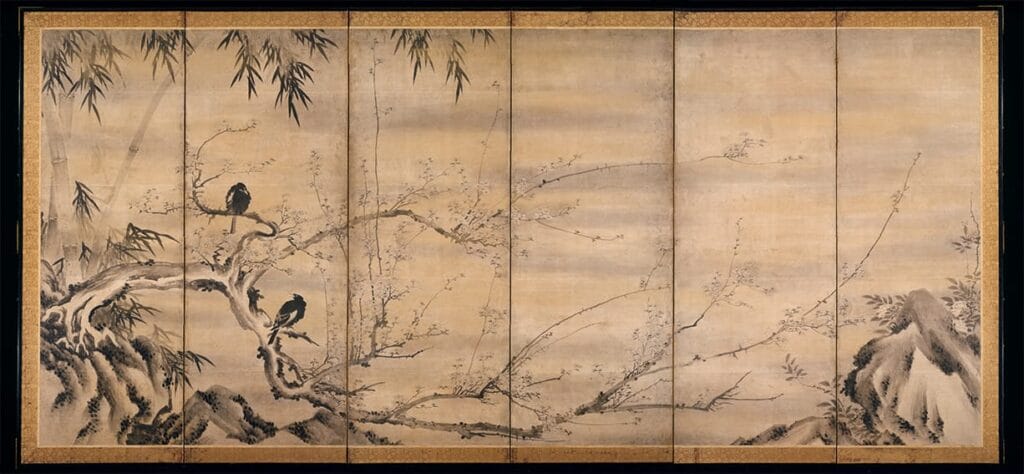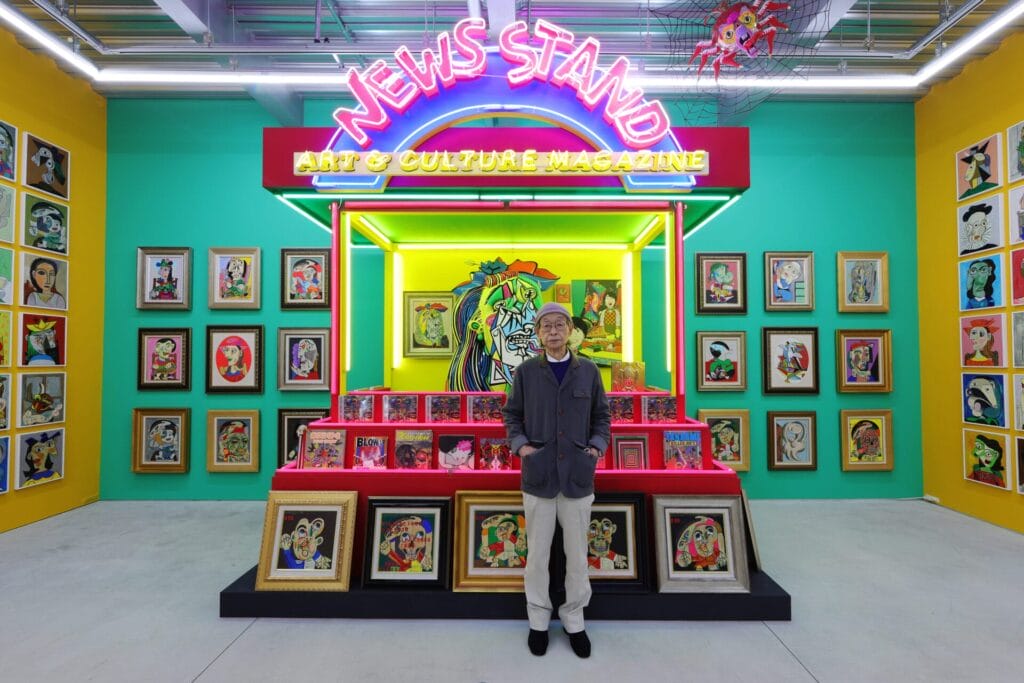Prada presents the exhibition “Paraventi: Keiichi Tanaami – パラヴェンティ : 田名網 敬一”, organized with the support of Fondazione Prada, at Prada Aoyama Tokyo from 3 November 2023 to 29 January 2024. The fifth floor of the building designed by Herzog & de Meuron hosts this solo show, curated by Nicholas Cullinan, in conjunction with the extensive group exhibition “Paraventi: Folding Screens from the 17th to 21st Centuries” on view at Fondazione Prada in Milan from 26 October 2023 to 22 February 2024.
The Milan exhibition explores the histories and semantics of these objects by tracing trajectories of cross-pollination between East and West, hybridization processes between different art forms and functions, collaborative relationships between designers and artists, and the emergence of newly created works. The folding screens embody liminality and the idea of being on the threshold of two conditions, literally and metaphorically. They cross barriers between different disciplines, cultures, and worlds.

Plum, Bamboo and Mynah Bird
six-panel folding screen, Late Muromachi Period (16th century) Courtesy of London Gallery, Tokyo
This project generates two emanations at Prada Rong Zhai in Shanghai and Prada Aoyama Tokyo. Both exhibitions arise particularly from artistic commissions focusing on how folding screens are currently influenced by our pervasive digital experience of layering and screens within screens.
Before the advent of mechanical image processing techniques in the 19th century, a screen was not a place of visibility but mainly a protective element. This contrast between revelation and concealment survives today mainly in the screens of our devices, at once opaque and transparent windows. Screen images provide virtual, in-depth access to archives and databases and conceal the functioning of hardware, perpetuating an ambiguous relationship between surface and depth.
The Tokyo show explores the narrative and performativity dimension of folding screens, alluding to their deployment as props for the Kabuki Theater and in the Kamishibai, a form of street theatre and storytelling by paper images that originated in Buddhist temples in 12th-century Japan and was popular during the Great Depression of the 1930s and the post-war period.

Keiichi Tanaami (Tokyo, 1936), one of the leading pop artists in Japan since the 1960s, created a new environmental work specifically for Prada Aoyama spaces, expanding the concept of his folding screen conceived for the Milan exhibition. His contribution includes a video installation that unfolds like a folding screen, a paravent collage, and a book-shaped sculpture with video mapping, emphasizing the notion of folding and evoking the Kamishibai tradition.
A combination of American pop culture themes with the stylistic features and techniques of Japanese illustration, such as ukiyo-e printing, shapes Tanaami’s commission. Characters from the cartoon and movie universe, set in surreal, psychedelic landscapes, meet iconic figures from artworks such as Pablo Picasso’s Guernica, expressing the rejection of the formal hierarchies of Neo-Dada.
By privileging methodology over medium, Tanaami’s practice crosses various languages, including graphic novels, collages, sculptures, paintings, and films. If his Milan folding screen results from the crystallization of moving images, the Tokyo installation could enact a reverse process, restoring the original performativity to the images that had inspired it. It will thus delve into contemporary and future declinations of the notion of the folding screen, further bringing to light its confrontation between what is concealed and revealed, withheld and unfurled.
The Tokyo exhibition also comprises a six-panel folding screen titled Plum, Bamboo and Mynah Birds by Terutada Shikibu, a Japanese ink and wash painter of the late Muromachi period (16th century). This ancient screen is a relevant example of employing the panelled structure to convey a sense of movement and atmosphere, subtly surpassing traditional landscape painting. It generates a dialectic with the kaleidoscopic and colourful intricacy of Tanaami’s style, revealing his connection to art history.

Biographical notes
Rising to prominence in the 1960s, Keiichi Tanaami (b. 1936, Tokyo) found early success by creating images now deeply forged in the cultural landscape of both Japan and the United States. He is widely considered the progenitor of the Superflat movement, embodied today by Takashi Murakami and Yoshitomo Nara, among others. Tanaami’s work first registered the influence of manga and the Neo-Dada movement in Japan, mingling with his childhood experience of the Second World War, a recurring motif via images of air raids, flares, and blasts of white light from the detonation of explosives. His paintings also reflect memories of Kamishibai —public theater productions for Japanese children— that beguiled his mind and eye as a child.
Tanaami’s artistic practice is likewise characterized by an intensive cross- pollination between modes of production—drawing, painting, collage, graphic illustration, film, and sculpture. In his large-scale works, American pop iconography is placed into complex conversation with historic forms of Japanese illustration, such as traditional ukiyo-e wood-block printing. Through these techniques, familiar American-born icons —Betty Boop, Western cowboys, and Superman, among others— are transformed into characters in the surreal and enveloping landscapes of the artist’s imagination. It is Tanaami’s fascination with American pop iconography and its collision with traditional Japanese imagery that explores the tension between disparate forces, such as the East and the West, violence and innocence, and commercial imagery and high art.
Tanaami’s work has been the subject of numerous international solo exhibitions at both public institutions and galleries, including recent presentations at Nanzuka Underground, Tokyo; Venus Over Manhattan, New York; Jeffrey Deitch, New York, Los Angeles; Almine Rech, Paris, London, Shanghai; Karma International, Zurich; and Kunstmuseum Luzern Luzern, among others. Tanaami’s work is held in the permanent collections of public institutions around the world, including the Museum of Modern Art, New York; Yokohama Museum of Art, Yokohama; the Art Institute of Chicago; the National Portrait Gallery, Washington, D.C; National galerie im Hamburger Bahnhof – Museum fur Gegenwart, Berlin; M+ (Museum fo Visual Culture), Hong Kong; and the Walker Art Center, Minneapolis, MN, among many others.









